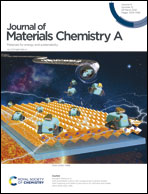Modulating a 2D heterointerface with g-C3N4 mesh layers: a suitable hetero-layered architecture for high-power and long-life energy storage†
Abstract
Two-dimensional (2D) heterostructures combine the advantageous features of different 2D materials and represent advanced electrode architectures for the development of efficient energy storage devices. However, common 2D heterostructures made by stacking different 2D sheets in van der Waals (vdW) contact impose obvious limitations in light of the energy storage performance. Here, we shed light on how heterointerface conditions exert a great influence on the electrochemical properties of the heterostructured electrode and provide an example to modulate the interface contact mode via sandwiching unique g-C3N4 mesh (m-g-C3N4). We find that such m-g-C3N4 bonded heterointerfaces can greatly increase the electrochemical activity, redox conversion kinetics and structural integrity of the constituent component (NiS2), manifesting excellent electrochemical performance with respect to vdW heterostructures. Experimental characterization along with theoretical simulations demonstrates that the synergistic effects of the mesh-bonded interfacial contact and plenty of in-between porous channels contribute to superior electrochemical performance. This study directs attention to elaborate interface engineering toward high-performance energy storage and paves the way for designing and manufacturing of advanced heterostructured electrodes for supercapacitors, batteries and other hybrid devices.



 Please wait while we load your content...
Please wait while we load your content...